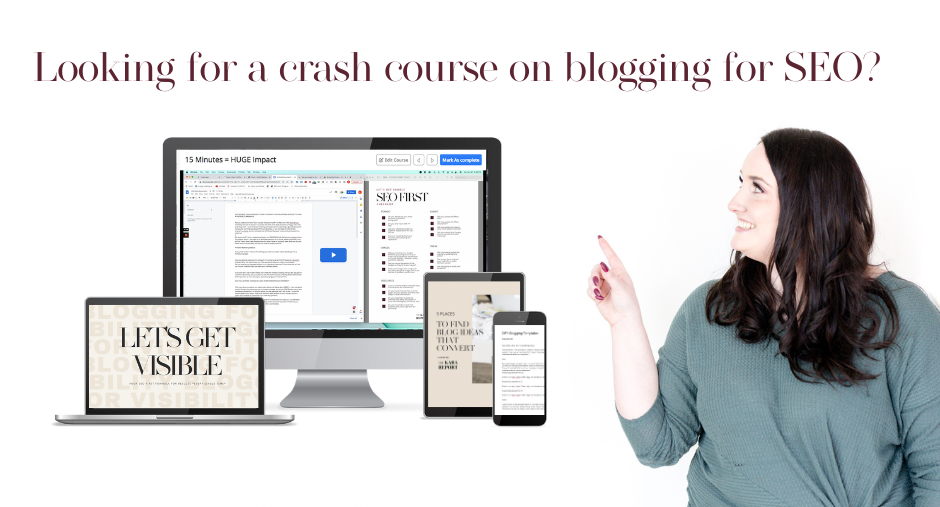Blogging is one of the most powerful marketing tools for small businesses—but only if you have a strategy. A well-planned blog can boost your SEO, drive traffic, generate leads, and build trust with your audience. But without a clear direction, it’s easy to waste time writing posts that don’t get results.
That’s where a blog marketing strategy for small businesses comes in. Instead of guessing what to write about, you’ll have a structured plan that aligns with your business goals, attracts the right audience, and keeps your content working for you long after you hit publish. And if the idea of planning, writing, and optimizing your blog sounds overwhelming—we’ve got you covered. We help small businesses create high-performing blog content that ranks, engages, and converts.
Ready to turn your blog into a lead-generating machine? Let’s dive into the step-by-step process—or if you’d rather have an expert handle it for you, let’s chat. 😉
Table of Contents
Step 1: Define Your Blog’s Purpose & Goals
Before you start writing blog posts, you need a clear purpose and strategy. Blogging without a goal is like throwing darts in the dark—you might hit something, but it’s mostly luck. Instead, a well-defined blog marketing strategy ensures that every post serves a bigger purpose for your small business.
Ask Yourself: What Do I Want My Blog Marketing Strategy to Achieve?
Your blog isn’t just a place to share random updates. It should drive results for your business. If it didn’t, why would you bother spending time or monty on it?
Here are a few common blog marketing strategy goals for small businesses (from our clients!):
- Increase brand awareness – Establish your business as an industry leader.
- Boost website traffic – Bring more potential customers to your site.
- Generate leads – Use blog content to attract and nurture potential buyers.
- Educate & build trust – Answer customer questions and position yourself as an expert.
- Improve SEO – Rank higher on Google and get found by the right audience.
Pro Tip: The best blog marketing strategies focus on one or two key goals rather than trying to do everything at once.
Know Your Audience: Who Are You Writing For?
Your blog marketing strategy will only be effective if it speaks to the right people. Instead of writing for “everyone,” narrow your focus to your ideal audience. Ask yourself:
- Who are my ideal customers? (Demographics, interests, pain points)
- What problems or questions do they have?
- What type of content would they find valuable?
For example, if you run a boutique marketing agency, your audience might be small business owners struggling with content creation. If you sell handmade jewelry, your audience might be people looking for unique, high-quality gifts.
Align Your Blog Content with Your Business Goals
Now that you know why you’re blogging and who you’re writing for, the next step is making sure your content aligns with your business goals.
Here are some examples (and yes, you can choose more than one goal!).
| Business Goal | Blog Strategy |
|---|---|
| Get more website traffic | Write SEO-optimized blog posts with trending industry keywords |
| Generate leads | Offer a free resource (e.g., a checklist or guide) in exchange for email sign-ups |
| Build trust & authority | Publish in-depth how-to guides and expert insights |
| Convert readers into customers | Include clear CTAs linking to your services or products |

Step 2: Keyword Research & SEO Strategy
Blogging without an SEO strategy is like building a beautiful store in the middle of nowhere—no matter how great it looks, no one will find it. That’s where keyword research comes into play in your blog marketing strategy. By strategically choosing topics that people are already searching for, you can drive consistent, organic traffic to your website.
If this sounds overwhelming, don’t worry—I’ll break it down into a simple, repeatable process. And if you’d rather focus on running your business while I handle the SEO-heavy lifting, I can help with that too!
Finding the Right Keywords For Your Blog Marketing Strategy
The key to a successful blog marketing strategy is writing about topics your audience is already searching for. Here’s how to find them:
1. Brainstorm Core Topics – Start by listing broad topics related to your business. For example:
- A social media coach might focus on “Instagram marketing tips.”
- A handmade jewelry brand might target “how to clean sterling silver jewelry.”
2. Use Keyword Research Tools – Free and paid tools like Google Keyword Planner, Ubersuggest, Ahrefs, and SEMrush can help you find high-volume, low-competition keywords to target. We personally love SEMRush for our clients (because it gives you a LOT better data than the free or low-cost tools).
3. Check Google’s Auto-Suggestions & “People Also Ask” – Start typing a phrase into Google, and see what autocomplete suggests. These are real searches! Also, check the People Also Ask section for inspiration.
Pro Tip: Focus on long-tail keywords (phrases with 3+ words), which tend to be less competitive but more specific. For example:
- ❌ “Email marketing” → Too broad, hard to rank for.
- ✅ “Email marketing tips for small businesses” → Easier to rank, more targeted.
Step 3: Content Planning & Topic Ideation
Once you have your keywords and SEO strategy, the next step in your blog marketing strategy is to create a content plan that keeps your blog consistent, engaging, and aligned with your business goals. Without a plan, blogging can quickly become overwhelming—or worse, inconsistent. That’s why we recommend mapping out your blog content one quarter at a time (or hiring us to do it for you).
If you’re thinking, “This sounds like a lot of work…”—you’re right! But that’s exactly why we do it for our clients. 😉 Let’s break down the process so you can implement it yourself (or let us handle it for you!).
Creating a Blog Content Calendar
A blog content calendar is the roadmap of your blog marketing strategy—it helps you stay organized, plan ahead, and ensure you’re covering a variety of relevant topics. Here’s how to do it.
1. Choose 6-24 Blog Topics for the Next 3 Months
- Aim for 2-8 posts per month, depending on your bandwidth.
- Use the keywords you researched in Step 2 to guide topic selection.
- Keep content balanced between evergreen topics (always relevant) and seasonal/trending topics.
2. Mix Up Your Content Types
When it comes to your blog marketing strategy, different types of blog posts can engage readers, build authority, and improve SEO. Here are some proven formats:
- How-To Guides & Tutorials – Step-by-step posts that solve common problems. (Ex: “How to Start a Blog for Your Small Business”)
- Listicles & Resource Roundups – Easy-to-digest, shareable content. (Ex: “10 Blog Post Ideas to Attract More Customers”)
- Case Studies & Success Stories – Showcase your expertise and build credibility. (Ex: “How We Helped a Local Bakery Increase Website Traffic by 200%”)
- Industry Insights & Trend Reports – Establish authority by discussing current trends. (Ex: “The Future of Blogging: What Small Businesses Need to Know”)
- Behind-the-Scenes & Company Updates – Humanize your brand and connect with readers. (Ex: “What Goes Into Writing a High-Performing Blog Post”)
3. Assign Publishing Dates
- Decide when each post will go live.
- Plan for seasonal content (e.g., holiday marketing tips in Q4).
- Leave room for flexibility in case new trends or business updates arise.
Pro Tip: If you have a service launch, sale, or promotion coming up, plan your blog content to support your marketing efforts.
Repurposing Blog Content
Don’t forget to include repurposing blog content for your blog marketing strategy. A single blog post shouldn’t just live on your website—it should be repurposed across multiple platforms to extend its reach and maximize your content efforts.
Here’s how to repurpose one blog post into multiple pieces of content:
- Social Media Posts – Turn key points into Instagram carousels, LinkedIn posts, or Twitter threads.
- Email Newsletters – Use blog content in your email marketing campaigns.
- Short-Form Videos – Summarize key takeaways in a TikTok, Instagram Reel, or YouTube Short.
- Infographics – Turn blog stats or step-by-step guides into shareable graphics.
- Podcast or Webinar Topics – Expand on blog topics in a different format.
By repurposing your blog content, you save time while reaching more people—it’s a win-win! I love when our clients use the blogs we write for other things!
Step 4: Writing High-Quality, Engaging Blog Posts
A great blog post does more than just fill space on your website—it grabs attention, provides value, and drives action. Start with a compelling headline that includes your target keyword and sparks curiosity. Then, hook readers with a strong introduction that highlights their pain points and promises a solution. Use clear subheadings, short paragraphs, bullet points, and visuals to keep content easy to read and engaging.
SEO is key, so naturally include your primary keyword in the title, first 100 words, subheadings, and meta description. Write in a conversational tone, use active voice, and make content scannable—most readers skim before they commit. Finally, end with a clear call to action (CTA), whether it’s booking a consultation, signing up for your email list, or checking out your services.
Don’t have time to write SEO-optimized, engaging blog posts consistently? You know what to do.
Step 5: Track Your KPIs
Blogging isn’t a “set it and forget it” kind of thing—you’ve gotta track what’s working and tweak what’s not. Otherwise, what’s the point of a blog marketing strategy? That’s why we use a mix of Google Search Console, SEMrush, and Enji to keep an eye on blog performance for our clients. These tools help us see which posts are ranking, what keywords are driving traffic, and where people are dropping off—so we can adjust the strategy accordingly.
One of the biggest things we look at? KPIs that actually matter. Sure, traffic is great, but are people sticking around, clicking through, and converting? If a post isn’t performing well, we’ll update it with fresh content, optimize for better keywords, or tweak the formatting to make it more engaging. And if a post is killing it? We’ll double down—repurposing it into social media content, emails, or even videos to get even more mileage out of it.
At the end of the day, a blog marketing strategy is only valuable if it’s getting results—and that’s exactly what we help our clients do. If you want a blog strategy that actually works (without spending hours staring at Google Analytics), let’s chat!
